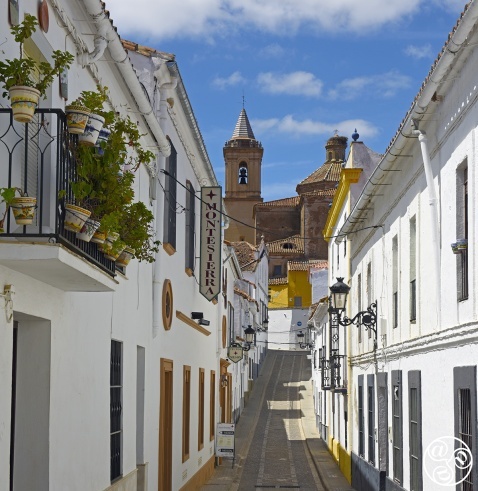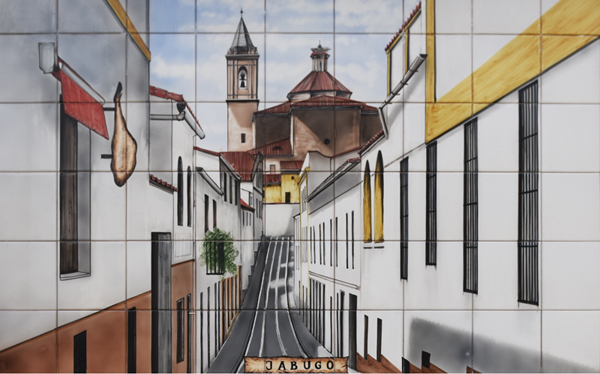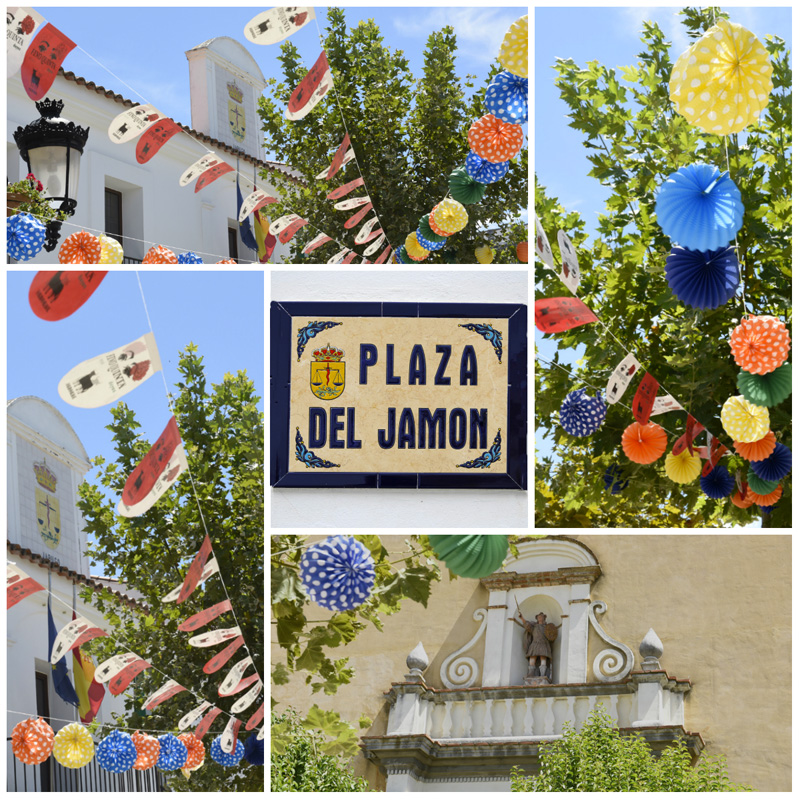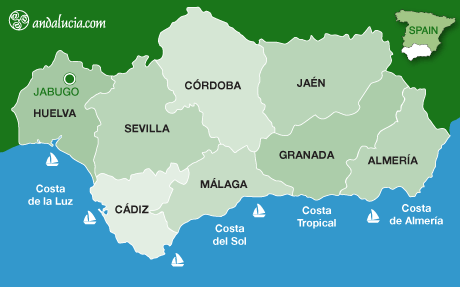
Calle Barco leads from the main shopping street to the 18th-century Iglesia de San Miguel |
|
JABUGO
Although at first Jabugo is one of the less picturesque villages in the Sierra de Aracena, with abattoirs and factories littering its outskirts to feed the local jamon iberico industry, the old centre is as attractive as any Aracena town.
Precisely because of the ham, Jabugo is the best place to stop at one of the bars or restaurant to sample the famous cured ham and other pork products which are produced here - and buy some to take home.
Jabugo has about 2,500 inhabitants, and has three other municipal districts or dependent villages called El Repilado, Los Romeros and El Quejigo.
JAMON IBERICO
For many Spanish people, Jabugo is shorthand for jamón Ibérico or pata negra (so-called because of the Iberian pig's distinctive black trotters). The finest - and most expensive - grade of cured ham is called jamon iberico de bellota, since the major component of the pigs' diet for a period is acorns. More about Jamon in Gastronomy Section >
Things to see
Calle Barco
This photogenic street leads up to Plaza del Jamon and the parish church, San Miguel.
Plaza del Jamon
Officially called Plaza de España, this pretty main square in the old town area is the location of Iglesia de San Miguel and the Casino, and also the original Casa Irene shop selling jamon serrano and other local produce.
Casino
Situated in the main square, this is nothing to do with gambling; many towns have a casino - the traditional social club; visitors are welcome. Read more about Jabugo Casino >
Iglesia de San Miguel
The original church (perhaps just a baptismal chapel) was built here in the 16th century, but the current one dates from the 18th century. Constructed from stone and brick, it is typical of Seville architecture of the period - neoclassical combined with local baroque. It has three naves, the side ones smaller, with five sections, a transept and a square apse (area behind the altar). The gospel nave ends in the chapel of the Shrine and the Epistle and entrance to the sacristy.
The centre nave has a barrel vault with small windows, while the Tabernacle has two sections, one with groin vault and one with elliptical vault. The church has two entrances; the main door is located at the front of the building, and the side door leads to a chapel and access to an added-on pastoral house. The original altarpiece dates from 1773 and was the work of Juan Evaristo Marin and Ignacio de Silva Mora. What you see now, if the church is open, is a copy of the original by Manuel Cerquera, commissioned to replace the original which was destroyed in 1936. In the church four sculptures are conserved: San Pedro, San Pablo in the sacrament chapel, and the two archangels in side niches of the dressing room. The pulpit is 18th century and the church organ dates from 1783.
Buy tickets for excursions from Seville

Casa Señoriales
Dotted around the town you will see a number of 18th-century mansions that belonging to wealthy merchants.
Tiro Pichón (Pigeon Shooting Lodge)
This grand 1920s building situated to the north of the village was designed by the Sevillano architect Anibal Gonzalez (1876-1929), chief architect for Great Exhibition in1929, whose centrepiece was Plaza de España in Seville. The Tiro Pichon is an imposing building in a prime hilltop location - it is said that the King Alfonso XIII, when opening the Grutas de Maravilla caves in nearby Aracena, pointed out the location in casual conversation. More about Tiro Pinchón >
El Repilado
This is the separate district that has grown up around the railway station. More >
Lavadero de Los Romeros
Old municipal washing facility located in the Los Romeros district.
Monumento al Maestro Jamonero
Bronze statue dedicated the jamon serrano workers who have toiled for years to produce the famed oro serrano (golden ham).

Hotels in Jabugo
Book Hotels in Jabugo
Things to Do
If you want to see at close quarters how the ham is made, you can visit the factory of the biggest and most established jamón producer, Cinco Jotas, which used to be called Sánchez Romero Carvajal. Here you can marvel at the thousands of jamones hanging from the ceiling. Tours last 1.25 hours and cost 12€ and start at 10.30, 12.00, 16.00, 17.30. There is also a shop open from 10.00 to 19.00 on Monday to Saturday and 10.00 to 14.00 on Sunday.
Tourist Information
Located on corner of Calle Doctor García Sánchez and Calle Castela.
Restaurants
Las Bellotas on the main street almost opposite Calle Barco is owned by the Cinco Jotas group and is the best restaurant in the town. There are numerous others along the same street.
History
Archaeological remains date the original settlement as Paleolític. Tools made from bones found in nearby Cueva de la Mora were dated as 5000 BC, the oldest in the Sierra de Aracena.
The name Jabugo comes from the word elder (or elderberry), or more correctly the genus sambucus as sabugu or xabugu in the old Leonese language that predated Castilian Spanish.
After the reconquest this area came under the Kingdom of Seville and was repopulated by people form Galicia, Asturias and Leon. Jabugo then belonged to the town of Almonaster la Real until it gained its independence in 1691. Thanks to the arrival of the railway and station nearby, Jabugo has grown both in size and economically.
Handicrafts
Traditional handicrafts are bobbin-made lace and embroidery.
Gastronomy
The popular ingredient is jamon serrano and anything derived from pork.
Festivals
Feria de San Miguel for three days around 22 to 26 September; Festival of San Juan on 24 June; Nuestra Señora de los Remedios on the second Sunday in July, when village brides offer bouquets of flowers to the Virgen de los Remedios, and recently baptized children are presented to the virgin. Santísima Trinidad is a romeria celebrated on the Sunday after Pentecost
Country WALKS
There is a pleasant 3.5km-walk along the Ribera de Jabugo to Galaroza, starting from the municipal swimming pool. Walk towards the N-435 from the pool, passing under the road and turning immediately right down a dirt track. After 1km turn left and follow the shady path along the Ribera de Jabugo, ideal for hot summer days. Alternatively, rather than turning left after 1km, continue along the track 2km south to Castaño del Robledo.
Parking and Orientation
Enter on the HU-8122 from either end of the town and park as close to the centre or Carretera San Juan del Puerto, as you can. Calle Barco running perpendicular off it, is more or less the centre (see photo above) and is a pretty street looking up to the Plaza del Jamon and the parish church. All around are countless bars serving jamon and shops selling it.
Location
Jabugo is located close to the intersection of two main roads: the N-435 from Huelva and the A-49 Autopista del Quinto Centenario motorway north-south to Extremadura and the N-433 east-west for the Ruta de la Plata north from Sevilla to Portugal. Then take the country road HU-8122 into Jabugo.

